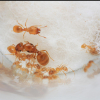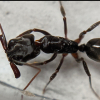I need help!
About a week ago, I noticed that one of my four Strumigenys pilinasis colonies was having some sort of mold outbreak that was killing all of the brood, not the live workers. Fast forward two days, and the rest of my S. pilinasis colonies are now struggling with this same mold issue, but thankfully my S. cf. clypeata colony has seemingly been contained from this mold. Since I didn’t know what to do, and all of my S. pilinasis colonies seemed to be on the decline, I attempted to merge them in hoping that their strength would be in numbers. Now I have an extremely large colony of S. pilinasis with about 20 queens and over 100 workers that are getting along great, but the mold just never stops. Every time an egg makes it to larvae or pupae, they simply succumb to the mold and die. What can I do to stop this nightmare?

This whole spot used to be filled to the brim with pupae:
Luckily, the queens are busy laying eggs, and I have a good supply of springtails to feed them now, so if this problem can be solved they should be able to recover.
Edited by CatsnAnts, August 8 2020 - 8:16 AM.



















